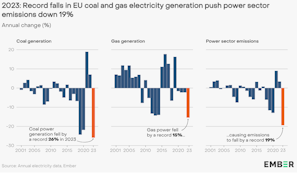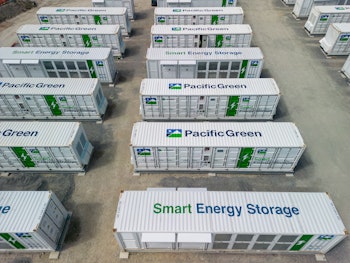Last year delivered a rare piece of good news for the climate as global temperatures hit new highs and extreme weather events battered communities worldwide.
The European Union (EU), which accounts for 6% of global primary energy consumption and about 8% of worldwide greenhouse gas emissions, saw a record 19% drop in fossil-fuel generation and power sector emission levels, according to energy think tank Ember.
The fall saw fossil fuels producing less than a third of EU electricity, said the firm in its 2023 European Electricity Review. Meanwhile, renewable energy surged to make up a record 44% of the EU electricity mix, supplying more than two fifths of the bloc’s generation capacity for the first time in modern history.
“A record fall in coal, gas and CO2 emissions in 2023 left the EU with a cleaner electricity mix than ever, as renewables took major steps forward,” Ember reported. “The EU’s electricity transition is in full swing.”

Wind power led the charge for renewables growth, producing 55 terawatt-hours of energy throughout 2023 and besting gas for the first time in the generation stakes. Growth in wind capacity, following a post-pandemic slump, saw it becoming the second-largest source of grid power in the EU, behind nuclear.
“2024 could be the year of the battery”
Solar power has also seen increasingly large capacity additions since the COVID-19 emergency, boosting intermittent renewables’ share of electricity production to 27%, an all-time high. Together, wind and solar were the biggest contributors to electricity generation in the EU, beating nuclear by 5%.
Ember noted that growth in wind and solar had almost eliminated coal generation in Italy, Spain and the Netherlands, and was starting to eat into gas’s share of electricity production in these markets—which jointly accounted for 51% of all EU gas-fired generation in 2023.
Furthermore, said Ember, “Clean generation reached more than two-thirds of EU electricity, double fossil’s share, as hydro rebounded and nuclear partially recovered from last year’s lows alongside the increase in wind and solar.”
Fossil fuels are definitively on the way out in Europe, Ember said, with coal generation expected to drop further with a wave of plant closures in 2024. Meanwhile, “in many countries, gas will be next to enter terminal decline,” said the firm.
A significant factor in last years EU electricity generation trends was a 3.4% year-on-year drop in demand. “With increased electrification, this rate of demand fall is not expected to be repeated in the coming years,” Ember said, predicting up to a 3% rise in 2024.
“To reduce fossil fuels at the speed required to hit EU climate goals, renewables will need to keep pace as demand increases,” Ember continued.
But it added: “The EU is firmly on its way to transition from a fossil-based system to one where wind and solar are the backbone.”
While the progress is welcome, more needs to be done, said Ember. To reach the EU’s REPowerEU target of 72% renewable electricity by 2030, the pace of renewables growth needs to almost double over the next seven years, it said. Meanwhile, grid operators must work fast in adapting to a generation mix based on intermittent renewables.
Some are already facing spells where renewables cover all of electricity demand. Portugal went for six consecutive days with nothing but renewable power in November 2023, while in the Netherlands last June there were around 140 hours where wind and solar production exceeded total electricity demand.
How should grid operators cope with this? One obvious answer is by increasing grid interconnection capacity. Two decades ago, German researcher Gregor Czisch demonstrated how wind power could supply the bulk of Europe’s electricity needs if the energy could be carried over a wide-enough area.
However, grid upgrades are notoriously costly and time-consuming, particularly where transnational connections are concerned. Thankfully, said Ember: “Building new poles and wires is not the only solution. There are alternatives, including additional flexibility mechanisms such as storage and demand-side response.”

A bankable, mature technology
Energy storage systems are particularly interesting because they can be built using lithium-ion batteries—a bankable, mature technology—with minimal delay. Pacific Green, for example, completed its first battery project, in Richborough, UK, in just 18 months from the start of construction.
Planning and permitting for battery energy parks is also relatively straightforward since the developments have no serious environmental impact. According to industry sources, the EU will need up to 200 GW of storage capacity to meet the 2030 REPower EU target.
Ember noted that growing grid congestion at times of high solar and wind production is already leading to significant levels of renewable energy curtailment in markets such as Spain and the Czech Republic.
However, it added: “Storage can accumulate the electricity produced by solar at times of low demand and shift it to other times of the day when it is needed most. The enhanced flexibility that storage provides is one of the ways to reduce incidents of price cannibalisation, negative prices and curtailment.”
Indeed, energy storage may be key to improving solar installation rates, since without it the prices that PV plant developers could get for the energy that they produce could fall to a level that nullifies the viability of new projects.
In Italy, for example, solar power alone was expected to fetch only 89% of the base price of electricity as of December 2023, but this could be increased to 97% with the addition of storage. In Poland, the situation is even more extreme, with solar on its own being valued at just 91% of the base price, rising to 100% with storage.
“Storage can also benefit consumers by reducing wholesale electricity prices, which ultimately feed into residential tariffs, by delivering power to the system at times when, currently, more expensive technologies are supplying the electricity at higher prices,” Ember observed.
Given the clear trend towards renewables in EU grids, and the suitability of batteries for overcoming renewable-related challenges such as price cannibalisation and curtailment, it is hard to see any downsides for storage in the wake of 2023’s records. On the contrary, said Ember: “2024 could be the year of the battery.”
Publish date: 20 March, 2024